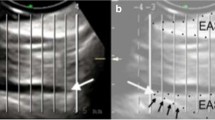Abstract
PURPOSE: This study was designed to test the hypothesis that the extent of anal sphincter muscle injury as graded at endosonography correlates with the degree of functional impairment. METHODS: Three hundred and thirty adults presenting for evaluation of fecal incontinence were recruited. Ultrasound was performed with a 7.5-MHz radial rotating axial endoprobe in the left lateral position. Anal sphincter muscle tears were graded on the basis of the degree of circumferential involvement (< or >25 percent) and by an assessment of the superoinferior longitudinal extent of an external anal sphincter tear. Muscles that demonstrated multiple tears, poor visualization, or fragmentation were classed as fragmented. Sphincter injuries were correlated with basal and squeeze pressures at manometry, pudendal nerve terminal latencies, and the severity of symptoms using the Parks-Browning clinical score. RESULTS: Patients with an intact external anal sphincter had a higher squeeze pressure (mean, 162.6 cm H2O) than those with a partial- (mean, 125.7 cm H2O) or full-length tear (mean, 124.9 cm H2O; P < 0.0001). There was no significant difference in squeeze pressure between those with partial- vs. full-length external anal sphincter tears nor between circumference tears < or >25 percent. Basal pressure was significantly lower in those with a full-length external anal sphincter tear (47.8 cm H2O) vs. an intact external anal sphincter (65.7 cm H2O; P < 0.001). The basal pressure in those with an intact internal anal sphincter was not significantly different from those with clearly defined internal anal sphincter tears, and the degree of circumferential involvement was also not important in this regard. However, those with a fragmented internal anal sphincter had a significantly lower basal pressure than other subgroups of internal anal sphincter injuries (P < 0.001). There was no association between external or internal anal sphincter status and the mean pudendal nerve terminal motor latency, suggesting the patient groups were neurologically similar. There was no significant association between external or internal anal sphincter status and the severity of reported symptoms. CONCLUSION: Correlations between the presence or absence of muscle tears and reduced manometric function have been identified. Further grading of tears was of less importance. No relationship between muscle injuries and the severity of clinical symptoms could be elicited.
Similar content being viewed by others
References
B Frenckner (1975) ArticleTitleFunction of the anal sphincters in spinal man Gut 16 638–644
B Frenckner CV Euler (1975) ArticleTitleInfluence of pudendal block on the function of the anal sphincters Gut 16 482–489
AP Zbar M Beer-Gabel AC Chiappa M Aslam (2001) ArticleTitleFecal incontinence after minor anorectal surgery Dis Colon Rectum 44 1610–1619
AH Sultan RB Johanson JE Carter (1998) ArticleTitleOccult anal sphincter trauma following randomized forceps and vacuum delivery Int J Gynaecol Obstet 61 113–119
S Karoui . Savoye-Collet E Koning AM Leroi P Denis (1999) ArticleTitlePrevalence of anal sphincter defects revealed by sonography in 335 incontinent patients and 115 continent patients AJR Am J Roentgenol 173 389–392
L Abramowitz I Sobhani R Ganansia et al. (2000) ArticleTitleAre sphincter defects the cause of anal incontinence after vaginal delivery? Results of a prospective study Dis Colon Rectum 43 590–598
N Rieger A Schloithe G Saccone D Wattchow (1998) ArticleTitleA prospective study of anal sphincter injury due to childbirth Scand J Gastroenterol 33 950–955
JM Jorge SD Wexner (1993) ArticleTitleEtiology and management of fecal incontinence Dis Colon Rectum 36 77–97
PJ Law MA Kamm CI Bartram (1991) ArticleTitleAnal endosonography in the investigation of faecal incontinence Br J Surg 78 312–314
KI Deen D Kumar JG Williams J Oliff MR Keighley (1993) ArticleTitleAnal sphincter defects Ann Surg 218 201–205
T Tetzschner M Sorensen G Lose J Christiansen (1996) ArticleTitleAnal and urinary incontinence in women with obstetric anal sphincter rupture Br J Obstet Gynaecol 103 1034–1040
MB Nielsen C Hauge JF Pedersen J Christiansen (1993) ArticleTitleEndosonographic evaluation of patients with anal incontinence AJR Am J Roentgenol 160 771–775
M Sorensen T Tetzschner OO Rasmussen J Bjarnesen J Christiansen (1993) ArticleTitleSphincter rupture in childbirth Br J Surg 80 392–394
JP Zetterstrom A Mellgren RD Madoff DG Kim D Wong (1998) ArticleTitlePerineal body measurement improves evaluation of anterior sphincter lesions during endoanal ultrasonography Dis Colon Rectum 41 705–713
GG Browning AG Parks (1983) ArticleTitlePostanal repair for neuropathic faecal incontinence Br J Surg 70 101–104
YP Sangwan JA Solla (1998) ArticleTitleInternal anal sphincter Dis Colon Rectum 41 1297–1311
M Wunderlich AG Parks (1982) ArticleTitlePhysiology and pathophysiology of the anal sphincters Int Surg 67 291–298
CJ Vaizey MA Kamm CI Bartram (1997) ArticleTitlePrimary degeneration of the internal anal sphincter as a cause of passive faecal incontinence Lancet 349 612–615
SJ Burnett C Spence-Jones CT Speakman MA Kamm CN Hudson CI Bartram (1991) ArticleTitleUnsuspected sphincter damage following childbirth revealed by anal endosonography Br J Radiol 64 225–227
F Voyvodic AC Schloithe DA Wattchow NA Rieger R Scroop GT Saccone (2000) ArticleTitleDelayed pudendal nerve conduction and endosonographic appearance of the anal sphincter complex Dis Colon Rectum 43 1689–1694
R Schafer T Heyer B Gantke et al. (1997) ArticleTitleAnal endosonography and manometry Dis Colon Rectum 40 293–297
AH Sultan MA Kamm CN Hudson JR Nicholls CI Bartram (1994) ArticleTitleEndosonography of the anal sphincters Clin Radiol 49 368–374
B Gantke A Schafer P Enck HJ Lubke (1993) ArticleTitleSonographic, manometric, and myographic evaluation of the anal sphincters morphology and function Dis Colon Rectum 36 1037–1041
WE Whitehead A Wald NJ Norton (2001) ArticleTitleTreatment options for fecal incontinence Dis Colon Rectum 44 131–144
TH Rockwood JM Church JW Fleshman et al. (2000) ArticleTitleFecal incontinence quality of life scale Dis Colon Rectum 43 9–17
CI Bartram AH Sultan (1995) ArticleTitleAnal endosonography in faecal incontinence Gut 37 4–6
LL Jensen AC Lowry (1997) ArticleTitleBiofeedback improves functional outcome after sphincteroplasty Dis Colon Rectum 40 197–200
C Savoye-Collet G Savoye E Koning et al. (1999) ArticleTitleAnal endosonography after sphincter repair Abdom Imaging 24 569–573
Author information
Authors and Affiliations
About this article
Cite this article
Voyvodic, F., Rieger, N.A., Skinner, S. et al. Endosonographic Imaging of Anal Sphincter Injury. Dis Colon Rectum 46, 735–741 (2003). https://doi.org/10.1007/s10350-004-6650-x
Issue Date:
DOI: https://doi.org/10.1007/s10350-004-6650-x




